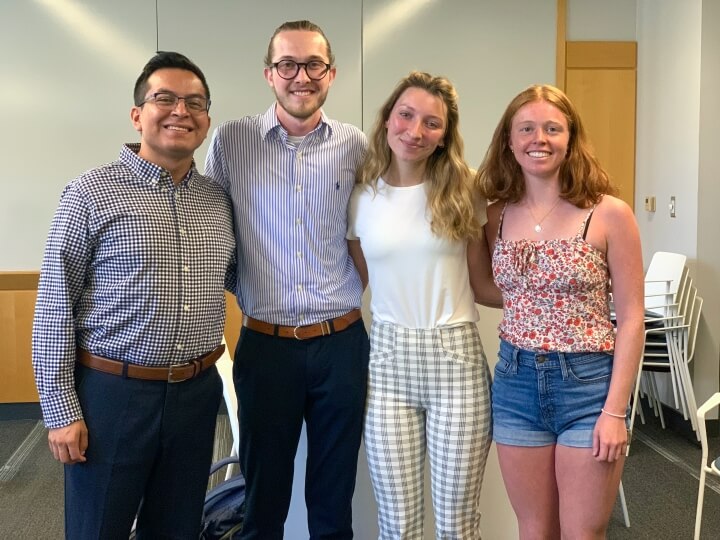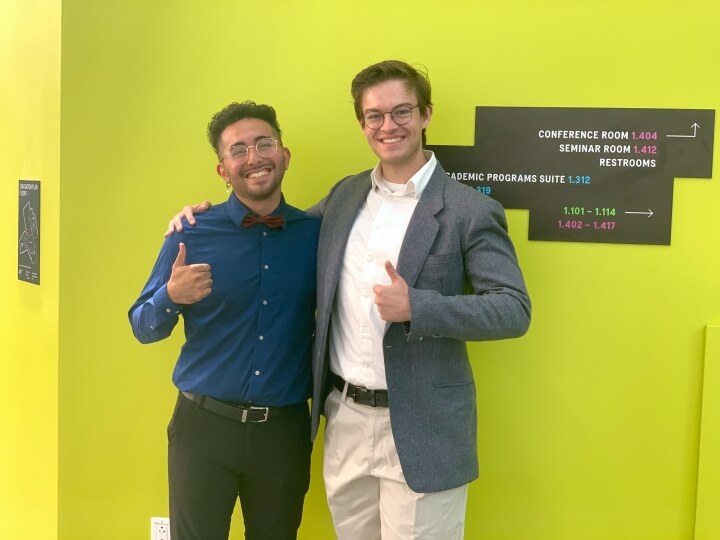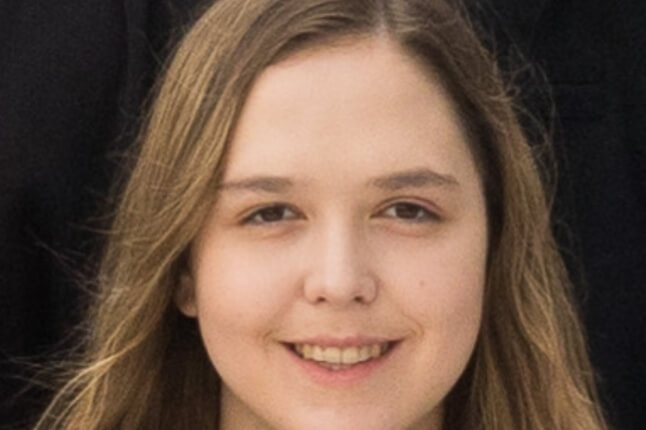News
SPHEER REU students Eduardo Lezama (Binghamton University), Leiv Berg (MiraCosta College), Greta Schultz (University of Wisconsin) and Lucy Gagnon (Williams College). (Matt Goisman/SEAS)
David Andrade, S.B. ‘23, a mechanical engineering concentrator at the Harvard John A. Paulson School of Engineering and Applied Sciences (SEAS), modeled reforestation strategies. Aidan Jones, a physics major at the University of Chicago, spent the summer studying what the magnetic properties of Martian meteorites can tell us about the solar system. Katherine Yang, a Williams College chemistry major, analyzed per- and polyfluoroalkyl substances (PFAS), also known as “forever chemicals,” in Massachusetts drinking water.
The Summer Program at Harvard in Earth and Environmental Research (SPHEER), funded by the National Science Foundation, is a new component of the SEAS Research Experience for Undergraduates (REU), a 10-week program that brings students from across the country to work in SEAS and Department of Earth & Planetary Sciences faculty labs. The students recently gave their final presentations, where they demonstrated their new skills and perspectives on engineering.
“In order to know what you want to do, you need to try out a bunch of things,” Jones said. “I was able to find an opportunity at Harvard that I wouldn’t have had at any other place. This was a wonderful place to get a little taste of what it’d mean to go into another discipline. It helped me think about what I want to do later in my life, and what I value in my work.”
Eduardo Lezama, an environmental science major at Binghamton University, studied seismology for the first time through the SPHEER REU, his project focusing on ground motion detection of oceanic storms. Even though Leiv Berg, a chemistry major from MiraCosta College in California, had almost no physics knowledge before he got here, he learned computational and atmospheric physics to study how relative humidity relates to cloud formation and precipitation.
“This has been an absolutely great experience, and I would totally recommend it to anyone,” Berg said. “I enjoyed the challenge of learning something completely new. I actually think I might try to go into environmental science with my chemistry degree.”
SPHEER REU students Avery Haynes (Vanderbilt University), Katherine Yang (Williams College) and Katherine Yang (Northwestern University). (Matt Goisman/SEAS)
Some of the SPHEER students arrived with an environmental science background, but all found new learning opportunities. Greta Schultz is majoring in atmospheric and oceanic science at the University of Wisconsin, and this summer researched emergency monitoring for California wildfire smoke.
“I live in California, where wildfire smoke is pretty prominent. With climate change and rising temperatures, it seemed like a common issue,” Schultz said. “I learned so much about math, public speaking, and what goes into day-to-day research. I learned a lot of skills, and it was an amazing experience.”
For her REU project, Lucy Gagnon, a chemistry and mathematics major at Williams College, used satellite data to study air quality in East Asia. The project required her to learn coding and data science, two invaluable skills for engineers across all disciplines.
For Yang, the SPHEER REU was a chance to do research focused on the environment, rather than laboratory chemistry that could have environmental applications. Another Katherine Yang (no relation) is studying computer science and chemistry at Northwestern University, but had yet to learn about machine learning and neural networks. She used both to create better wind turbulence models, which could be used for climate modeling and better placement for wind farms.
“Looking back on it, I’m really proud and happy that I’ve grown so much through this experience,” the Northwestern rising sophomore said. “I’ve learned so much about computer science that I don’t think I otherwise would have learned.”
Avery Haynes, a chemical engineering student at Vanderbilt, didn’t have the opportunity to do lab research during her freshman year. Her REU project on plate tectonics was her first time tackling a long-term research project.
“It was very scary at first, but it ended up being really great,” she said. “I learned something new that I would not have done before, and I’m starting to think environmental chemistry, specifically sustainable engineering, would be a route I’d want to go in the future.”
SPHEER REU students David Andrade (S.B. '23) and Aidan Jones (University of Chicago). (Matt Goisman/SEAS)
Aerospace engineering dominated Andrade’s time at SEAS, but he’ll soon depart for Kenya to study climate change and wildlife conservation. For him, the REU was a chance to expand his engineering skill set, as well as begin to transition from one area of engineering to another.
“Harvard engineering is about exploring a bunch of different areas, then using them to form a broader and more-informed perspective on how the world works,” he said. “That leads to better engineering outcomes, and better group-work outcomes. Novel ideas come from taking expertise from different fields. I see it not only as a suggestion, but a requirement for engineers to try different fields.”
The SPHEER REU also included the popular HazeL team project. Led by Harvard graduate student Jack Bruno, participants were given portable monitors of airborne particulate matter and were then sent into the field to measure air quality, including on days when significant smoke from the fires in Quebec arrived in the area.
The SPHEER program received support from the National Science Foundation (Grant #2150290).
Topics: Academics, Climate, Environment, Environmental Science & Engineering
Cutting-edge science delivered direct to your inbox.
Join the Harvard SEAS mailing list.
Press Contact
Matt Goisman | mgoisman@g.harvard.edu





